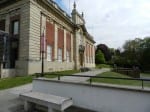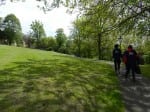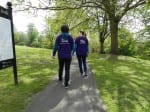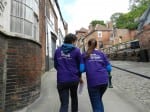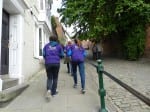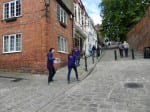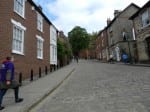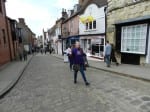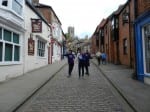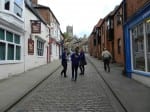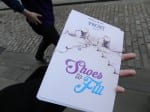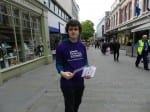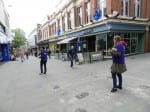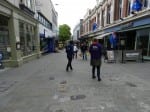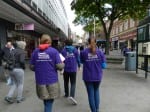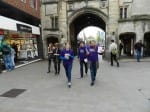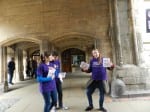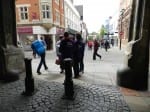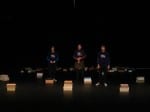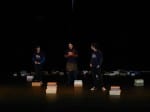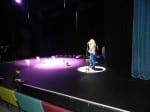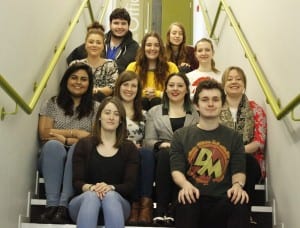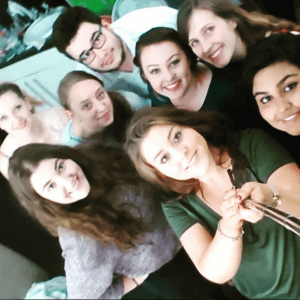Society is constantly submerged in digital content, theatre scholar Dominic Hingorani states “in a digitally saturated culture, many young people may have little direct experience of the live theatre and find it irrelevant” (Hingorani 2012, 59). As a theatre company we had to acknowledge how society receives content about the world around us therefore, to create theatre that is relevant to our audiences we had to incorporate technology. A theatre piece called Mad Blud (2008) written by Phillip Osment, is a verbatim theatre piece aimed at young audiences. The piece was themed around knife crime in the city and incorporated technology into the piece by having the actors listening to the live recordings on Mp3s on stage. By involving modern day technology it enabled actors to convey the true emotion of the interviewee. Performances like this inspired us to incorporate verbatim into our piece and have different stories of how members of society grew up; this became our central theme for our performance. We did this by compiling stories from us as a company and to then perform to each other, this gave us the confidence to further develop this idea and to further compile stories of how some grew up. However, I explained how we needed to compile stories from an array of people, as we were more likely to interview people who were of the same ethnicity and demographic. This would mean we would narrow our audience greatly and therefore we should make sure to interview people of different ages and races to reach with all members of society.
To be able to choreograph for this production I had to first expand my knowledge of physical theatre and explore the many practitioners of the genre. Physicality has been a part of theatre but the way the physical has been presented differs, scholars Simon Murray and John Keefe state, “one can trace an insistence on practise of embodiment, physical expressiveness and corporeal fluency” (Keefe and Murray, 2007, 17). Suggesting that physicality has been and still is connected to theatre and the technique of physicality has been developed and implemented by many pioneering practitioners.
The term itself ‘physical theatre’, seems to have evolved its meaning in recent years, where it once represented a genre where theatre and dance meet to create visually beautiful performances, now is being used to describe performances to seem less dull to audiences. Keefe and Murray further explain this phenomenon, “today it is often to be found as a strap line to identify the direct and aspiration of many young companies determined to resist the embrace of mainstream realism and naturalism” (Keefe and Murray, 2007, 16). The term has morphed into a ‘buzz word’ for companies to suggest to potential audiences the performance is not traditional theatre, it is to remove themselves from the image of naturalistic theatre. The term is to suggest a performance will be “fresh, cutting edge and risky” (Keefe and Murray, 2007, 13).
Whilst researching theatre companies one had stood out the most, Goat Island. The company had released a letter that was addressed to young and upcoming practitioners, it explained that bodies “are both art elements and tools that communicate intuitively” (Goat Island, 2007). The body is a tool and a tool that is able to assist the voice of an actor and ensemble in providing the audience with a true portrayal of a character and help the overall narrative of a performance. Keefe and Murray agree with having the verbal and the physical work hand in hand and suggest “the actor whose abilities are restricted to a glorious vocal range on an unimpressively lifeless body is easy” (Keefe and Murray, 2007, 14). When creating the choreography for the show I had tried to keep this in mind, how the body is a tool and should be used to further assist the audience’s understanding of the narrative of the scene and show. The vocalisation of a character’s emotion through the voice is capable by most actors, but to illustrate through the voice and body is demonstrating the actor’s capabilities as well as assist in the characterisation. The body is still able to present the emotios of character if the voice were to be taken. Physical Theatre is a complex genre and must understand the capabilities for a performance and this is what I as choreographer must understand.
Jerzy Grotowski, a Polish theatre director focused on the elimination of superfluous movement as Grotowski believed that the theatre had become too infected with extravagant costume, makeup, acting and staging. Grotowski stated, “theatre can exist without make-up, without autonomic costume and scenography […] without lighting and sound effects” (Grotowski, 1968, 19). The relationship between the actor and the audience was key in Grotowski’s methodology; he further states “our productions are detailed investigations of the actor-audience relationship” (Grotowski, 1986, 15). Grotowski believed theatre at the time did not focus on building a relationship and therefore created theatre that included the audience more.
I tried to make sure that the scenes in which I choreographed, helped develop the actor –audience relationship, I did this by getting the actors Oliver Samuals and Eden Shortt for the ‘Catholic vs. Church of England’ verbatim scene to connect to their character. By having the actors connect to their characters and their characters relationship to each other, they would enable to audience to also connect to the scene and its theme as Grotowski stated, “we consider the personal and scenic technique of the actor as the core of theatre art” (Grotowski, 1986, 15). Therefore, to create good theatre one must remember the actor’s technique is on trial and to develop the scene the acting technique must be at a high standard.
For the opening number, I choreographed movements that the actors could play with them and play the movements out to the audience but I also made sure the movements were not too strenuous as the actors would also be singing. I had been told by the writers that the ‘I Want Song’ is to replicate children and then at the end of the song they are in secondary school and so I tried to illustrate this through the movements. I took inspiration from musical numbers such as “Hairspray” (2002) by adding bigger and move fluid movements. By implementing larger movement directed towards the audience I was trying to have the actors play with their movements and for them to inject life and energy to the opening scene. Therefore, by having the actors play I was implementing a part of Grotowski, “[…] infinite variation of performer-audience relationships is possible. The actors can play among the spectators, directly contacting the audience and giving it a passive role in drama” (Grotowski, 1986, 20).
Similarly to Grotowski, Jacques Lecoq heavily focused on “the human body in movement and a commitment to investigating and encouraging the athleticism, agility and physical awareness of the creative actor” (Evan, 2012, 164). However, the two practitioners differ in their approach to the human body, Grotowski wanted to see how the body can be utilised to convey true emotion on the stage whilst Lecoq wants to understand and push the human body to its capabilities. However, incorporating the theories of Lecoq’s into practice became an issue. Evan states, “movement for Lecoq is a way of perceiving and engaging with life and the world around us” (Evan, 2012, 168). This had been what I tried to achieve in our performance but I had to first understand the ensemble’s capabilities and limitations, I did this deceivingly by carrying out warm ups to witness what the cast could do. It became apparent that the cast’s capabilities were not in physical theatre or movement however, they listened to instruction well. Understanding the cast and what seems achievable helped me put set actors in each of the choreographed scenes by the physical and emotional needs of the scene.
The scene in which I implemented Lecoq the most had been ‘The Forced Marriage’ scene, I focused on how the body could further assist the audience’s understanding of the scene without either outshining the verbatim or be too distracting for the audience. I did this by giving the actors a set of three to five movements to repeat and the movements corresponded with the verbatim dialogue. However, I got the actors to constantly exaggerate the movements to nearly looking absurd, this was to test if the images assisted the dialogue as well as keeping the audience’s attention and it worked. The movement tested the actors physicality as well keep the audience’s attention on stage whilst helping the audience empathise with the verbatim.
The audience had been an element that I tried to keep in mind throughout the module as without the audience there is no performance, Marshal states, “the audience isn’t telepathic; it only understands what is happening through what it sees and hears” (Marshall, 2001, 9). Therefore, the movements I created had a purpose, they assisted the audiences’ understanding of the events taking place in front of them but, this also applied to all scenes as Grotowski disliked the use of unnecessary movement. Similarly, Vsevolod Meyerhold a Russian and Soviet theatre director and actor believed the actors should use simple movements, Aleksei Levinski states, “It’s very important in biomechanics that you’re working with very simple things, very simple movements. You put them together and you can make something very complicated. But they are, in essence, simple” (Levinski, 1995). Having actors that are not experienced in physical theatre meant the movements I created were at their capabilities and very simple and effective. However, if the actor was more able I would push them further but still with simple movements.
As well as being choreographer for the performance, my second role for the performance was actor. However, this did not mean I did not give my 100% to the piece, a lesser role does not mean a lesser performance. There were a few scenes I was performing in and most of those there is no evident of a character except for the ‘Expectation vs. Reality’ scenes, but I still created characters for my scenes as that helped me to connect towards the text and therefore the audience. I created characters that were ranging from stubborn teen to inquisitive twenty year old. What assisted my characterisation the most was by implementing the character work I went through with my actors, the exercises provided two purposes, to help the characterisation of the actors and to see if it worked on me. By testing the exercises myself I was able to see if they worked by seeing if they helped my characterisation for the show, this boosted my confidence in the performance and as choreographer.
In regards to the last performance there are positives, negatives, regrets and achievements. The audience seemed to connect to the performance quickly and easily which made the overall performance run with a boost of confidence from the cast. The entire ensemble took a few chances on stage that seemed to pay off however, there were negatives such as projection which meant if I could notice it from the wings the audience would be struggling to. The songs were not sung as well as other times but that can be as most of the cast were non singers or slightly more able and with a sudden change to sing two songs acoustically due to tech and timing issues did not help the situation.
However, the audience connected and when the ‘Tinder’ scene had started the audience filled the room with laughter, the acting from the cast in the scene worked well because the characters were exaggerated and that complimented the bizarre dialogue. The characters could have been pushed a little further and be more expressive but the scene still worked. As for the ‘Catholic vs. Church of England’ scene I choreographed, I believed it worked well especially seeing as both actors were not dancers. But I could see there was room for improvement in regards to the dancing, the pace and the speed. Although I do believe there was an issue for the actors on who to listen to, either myself or the director. We both had differing visions for the scene and I was having the scene changed without my knowing or input.
This experience was a large learning curve on group work and group dynamic and demonstrated how vital and key the art of listening and being open minded to criticism is. There are a few key changes I would have made if I were to redo this, I would cut writers as this took up too much time waiting for a script when we should have been devising. I would also not have worked in such a large group as there were power imbalances and define roles from the start and explain what is expected and needed to be done. Finally, I would also make sure there was a plan for rehearsals that the whole group was aware of and make sure everybody was open to opinions. However, with the highs and the lows I believed what we achieved on performance night was good knowing what we went through as a group.
Work cited:
Evans, M. (2012) ‘The influence of sports on Jacques Lecoq’s actor training’, Theatre, Dance & Performance Training, 3, 2, 163-177.
Goat Island (2000) Letter To A Young Practitioner. [online] Chicago: Goat Island. Available from http://www.goatislandperformance.org/writing_L2YP.htm [Accessed 1 May 2014]
Grotowski, J. (1986) Towards a Poor Theatre. London: Methuen London Ltd.
Hingorani, D. ‘Creating theatre work for a diverse teenage audience’ in Theatre for Young Audiences: A Critical Handbook. Maguire, T & Schuitema, K (Eds.). (2012). Stoke-on-Trent: Trentham.
Keefe, J and Murray, S (2007) Physical Theatres: A Critical Introduction. London: Routledge.
Levinski, Aleksei (1995) Meyerhold’s Biomechanics: A Workshop, Exeter: Arts Documentation Unit (video).
Marshall, L. (2001) The Body Speaks: Performance and physical expression. 2nd edition. London: Methuen Drama.
